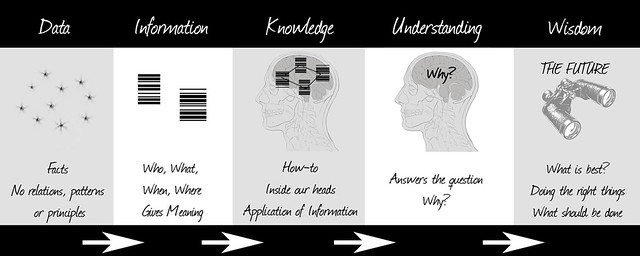|
|
|
Monday, April 29th, 2019
Poking through 11+ years of posts I find information that’s as useful now as when it was written.
Golden Oldies is a collection of the most relevant and timeless posts during that time.
Back in the late 2000s, when blogs were newish, there was a thing called Wordless Wednesday. The idea was to present your thoughts on a subject with a picture, instead of words. Anyway, I came across this one and it fit so well with a post I’m working on I decided to make it this weeks Oldie.
Read other Golden Oldies here.

Image credit: Nick J Webb
Posted in Golden Oldies, Personal Growth | No Comments »
Thursday, April 23rd, 2015

The other day I was asked, “When do you lead rationally vs. when do you lead emotionally?”
“Rationally” refers to communicating and appealing to those who are more cerebral, while “emotionally” means focusing more on feelings — it does not mean that one type is cold and the other overwrought.
People hear in different ways and it’s the responsibility of the speaker to communicate so that all can hear.
Over the years, I’ve been told many times by people in positional leadership roles that having to constantly alter how they present information is hard work and they believe that it’s up to the listener to understand what they’re saying.
What these bosses don’t understand is that if “they” can’t hear you “they” certainly won’t follow.
It’s not just a choice of rational vs. emotional, it’s understanding your audience and then speaking appropriately.
For instance, if you’re presenting plans for a new building to investors, business, the community and the media you might be inclined to concentrate on relative costs and ROI, since you want to win over the money crowd, but that doesn’t mean you should ignore the esthetics and ambiance.
First, you need to think about the different viewpoints and craft your presentation to include both types of information, even when it’s stuff about which you don’t care, that way you have it all at your fingertips.
During the presentation a money person suggests that construction costs could be lower by using smaller windows and lower ceilings and you know that this won’t fly with the community and business interests, since they’re concerned more with how the building will look and feel.
If you’ve done your homework, then you can show that higher ceilings and larger windows have been proven to increase worker productivity and the improved ambiance means higher rents.
Each group will focus on the information addressing their primary interest with the rest being relegated to backup position, but the important thing is that each heard something positive that directly addressed their concern.
Doing this is a habit you can cultivate and the fastest way to do so is to make yourself hyper aware of that to which your reaction is “who cares,” since that’s the information/viewpoint you’re most likely to skip.
While it’s not rocket science, it does require self-awareness supported by a driving passion to be heard.
While there’s never a guarantee that people will agree and follow, they will hear you and that’s where you need to start.
Image credit: Andy Morffew
Posted in Communication, Entrepreneurs, Personal Growth | No Comments »
Wednesday, April 4th, 2012

The following quotes are from an interview with Charlotte Beers, former chairwoman and C.E.O. of Ogilvy & Mather Worldwide, and meant specifically for women leaders.
As usual, I find that such insights and advice focused on a certain demographic is applicable to a much broader audience.
Don’t let someone tell you who you are. Keep your own scorecard, and it has to include the good, the bad and the ugly.
This is a humongous insight that qualifies as real wisdom.
Too often our perception of self is, in reality, a reflection of how our various worlds see and treat us; worse, that perception is often colored by negative experiences that happened to the person we were years ago and bear no relationship to who we are now.
Sometimes a company’s culture is a big influencer in how you see yourself, and you have to sift through that and see if it’s a fit. Part of it is knowing yourself so well that you know where you fit, and knowing yourself so well that you know why you work.
I would disagree and say that all of it, “it” being anything you do/try to do/want to do, is knowing yourself (the good, bad, ugly and inane).
Company culture as an influencer is more than sometimes, it is all the time. Culture is the atmosphere you breathe and the values by which you work. If you are not at least synergistic with the culture going in you will either leave or be co-opted into its vision of values.
Beers also talks about what she looks for when hiring.
I’m trying to understand how they used the power to hire and fire and promote and make those kinds of invisible choices that really affect other people’s lives. If they don’t have some generosity of spirit and some quality of teaching, I worry that they’re not going to bring along a strong culture.
I’m trying to find out if they have confidence about the things that matter, their own ability to think and to get to the true center of things.
The importance of these traits to a potential manager pales in comparison to their importance to the individual.
Understanding these things about yourself in conjunction with your scorecard provide a firm foundation on which to tweak the you-you-are, as well as to build the you-you-want-to-be.
Take a minute and read the entire interview—it’s well worth your time.
Flickr image credit: bradleypjohnson
Posted in Personal Growth | No Comments »
Monday, November 23rd, 2009
 The other day I was asked, “When do you lead/manage rationally vs. emotionally?” The other day I was asked, “When do you lead/manage rationally vs. emotionally?”
First, let’s define the terms so there’s no confusion in how they’re being used.
Rationally refers to communicating and appealing to those who are more cerebral, while emotionally means focusing more on feelings—kind of a left brain/right brain—not that one type is cold and the other overwrought.
People hear in different ways and it’s the responsibility of a speaker to communicate so that all can hear.
Over the years, I’ve been told many times by people in managerial roles that having to constantly alter how they present information is hard work and they believe that it’s up to the listener to understand what they’re saying.
As you might guess, I have little tolerance for this kind of thinking, especially when it persists after significant educational efforts. What these people never seem to get is that if “they” can’t hear you “they” certainly won’t do what you want.
It’s not just a choice of rational vs. emotional, it’s understanding your audience and then speaking appropriately.
For instance, if you’re presenting plans for a new building to investors, business, the community and the media you might be inclined to concentrate on relative costs and ROI, since you want to win over the money crowd, but that doesn’t mean you should ignore the esthetics and ambiance.
First, you need to think about the different viewpoints and craft your presentation to include both types of information, even when it’s stuff about which you don’t care, because that way you have it all at your fingertips.
During the presentation a money person suggests that construction costs could be lower by using smaller windows and lower ceilings, but you know that won’t fly with the community and business interests, since they’re concerned more with how the building will look and feel.
If you’ve done your homework, you can show that higher ceilings and larger windows have been proven to increase worker productivity and the improved ambiance means higher rents.
Each group will focus on the information addressing their primary interest with the rest being relegated to backup position, but the important thing is that each heard something positive that directly addressed their concerns.
Doing this is a habit you can cultivate and the fastest way to do so is to make yourself hyper aware of anything that that brings the thought “who cares,” since that’s the information/viewpoint you’re most likely to skip.
None of this is rocket science. It only requires self-awareness that’s backed by a passion to be heard. It’s also not a guarantee that people will agree, but they will hear you and that’s where you need to start.
Image credit: roland
Posted in Business info, Communication, Motivation | No Comments »
Thursday, April 30th, 2009
Do you understand what I write?
A few weeks ago I read that you should never use a thesaurus and always write using the simplest words possible. The object being that your readers never had to look up a word or think about your meaning.
 I didn’t comment at the time because I was too annoyed (good rule not to comment when you’re seething; that way you don’t regret it later), then my system crashed and I lost the link. I didn’t comment at the time because I was too annoyed (good rule not to comment when you’re seething; that way you don’t regret it later), then my system crashed and I lost the link.
Before the crash, out of curiosity I had checked and the post scored 7.2 on the Flesch-Kincaid Grade Level indicator
That fits with what I’ve always heard about newspapers and other media writing for a seventh grade reading level.
To me, this attitude is a major contributor the dumbing down of our population. I see it daily in the glaring difference between the articles in the NY Times and the locally written articles in my own newspaper.
In writing both my blogs I use my normal vocabulary developed from years of reading—mysteries (not thrillers), F&SF, biographies, business, and a lot of other stuff along the way. My posts typically score between 10.x and 12.x, so I’m curious.
Do you find them difficult to read or understand?
Do you really prefer writing at the 7.x level? (This post is 7.9)
Please take a moment and tell me what you think.
All comments through May 15 go in the hat for a random drawing. The winner will receive a copy of The Connected and Committed Leader: Lessons from Home, Results at Work by Laura Lopez.
Image credit: karindalziel on flickr
Posted in Business info, Communication, Personal Growth | 11 Comments »
|
 Subscribe to
Subscribe to
MAPping Company Success
About Miki 
Clarify your exec summary, website, etc.
Have a quick question or just want to chat? Feel free to write or call me at 360.335.8054
The 12 Ingredients of a Fillable Req
CheatSheet for InterviewERS
CheatSheet for InterviewEEs™
Give your mind a rest. Here are 4 quick ways to get rid of kinks, break a logjam or juice your creativity!
Creative mousing
Bubblewrap!
Animal innovation
Brain teaser
The latest disaster is here at home; donate to the East Coast recovery efforts now!
Text REDCROSS to 90999 to make a $10 donation or call 00.733.2767. $10 really really does make a difference and you'll never miss it.
And always donate what you can whenever you can
The following accept cash and in-kind donations: Doctors Without Borders, UNICEF, Red Cross, World Food Program, Save the Children
*/
?>About Miki
About KG
Clarify your exec summary, website, marketing collateral, etc.
Have a question or just want to chat @ no cost? Feel free to write
Download useful assistance now.
Entrepreneurs face difficulties that are hard for most people to imagine, let alone understand. You can find anonymous help and connections that do understand at 7 cups of tea.
Crises never end.
$10 really does make a difference and you’ll never miss it,
while $10 a month has exponential power.
Always donate what you can whenever you can.
The following accept cash and in-kind donations:
|







 The other day I was asked, “When do you lead/manage rationally vs. emotionally?”
The other day I was asked, “When do you lead/manage rationally vs. emotionally?” I didn’t comment at the time because I was too annoyed (good rule not to comment when you’re seething; that way you don’t regret it later), then my system crashed and I lost the link.
I didn’t comment at the time because I was too annoyed (good rule not to comment when you’re seething; that way you don’t regret it later), then my system crashed and I lost the link.
